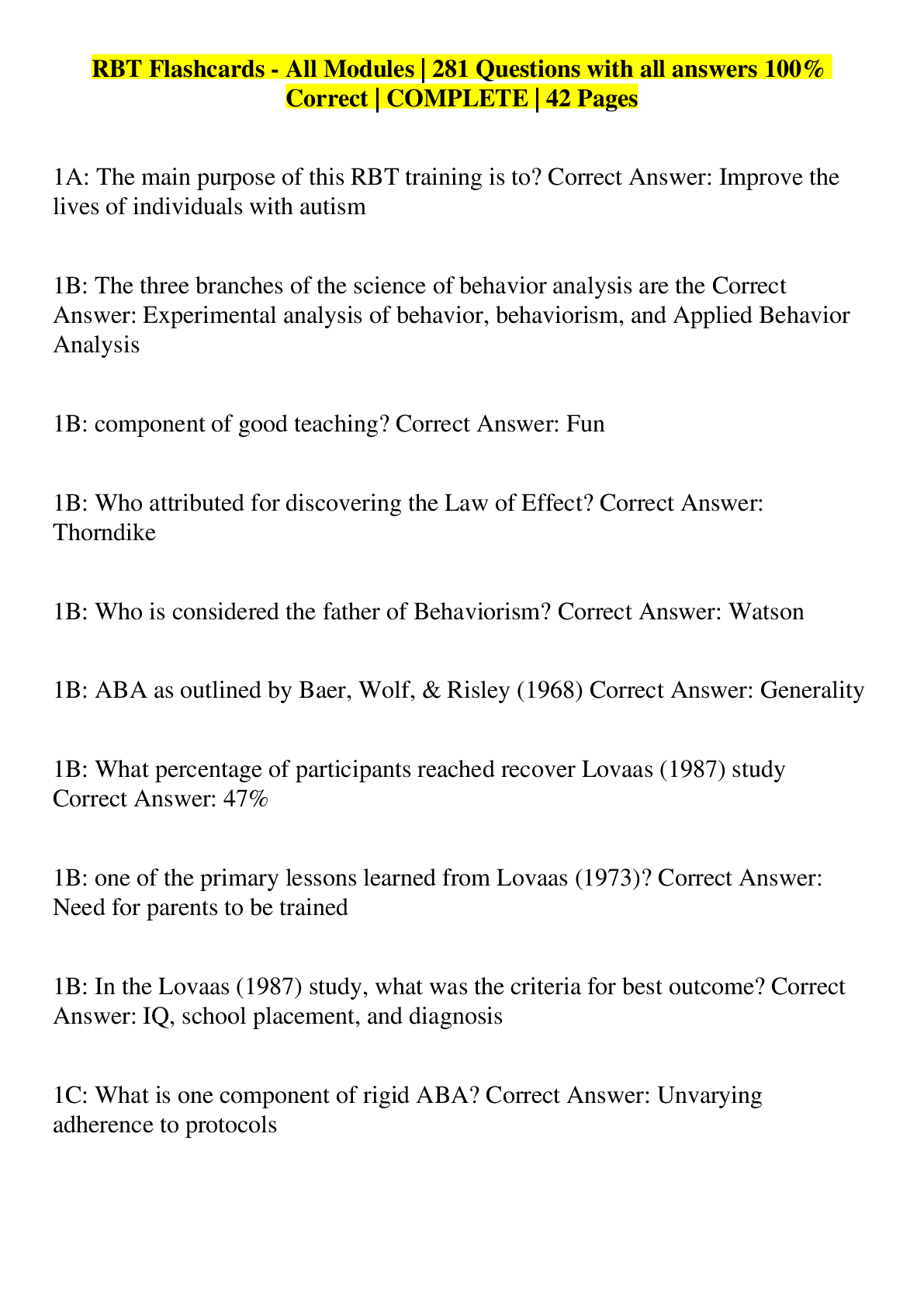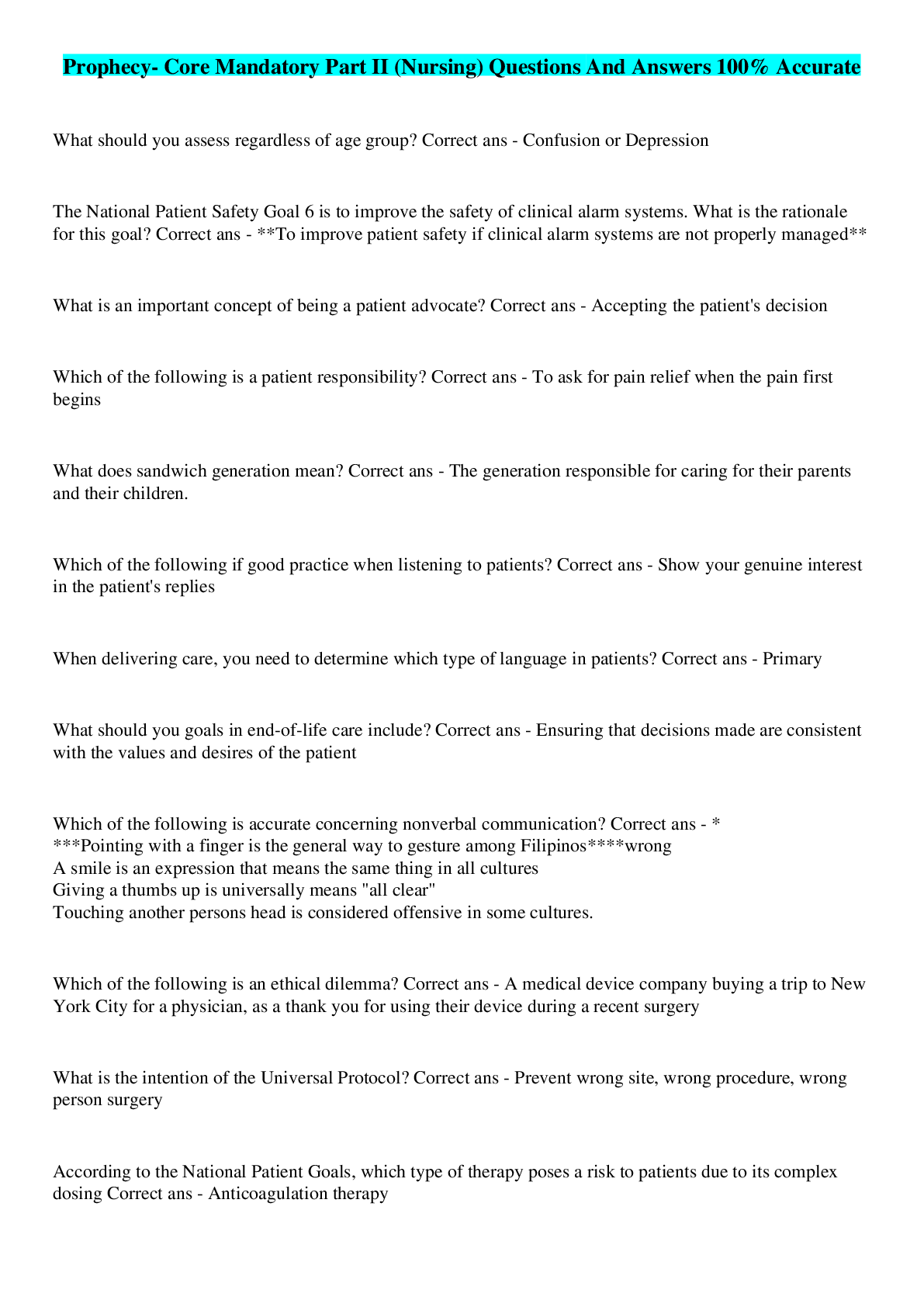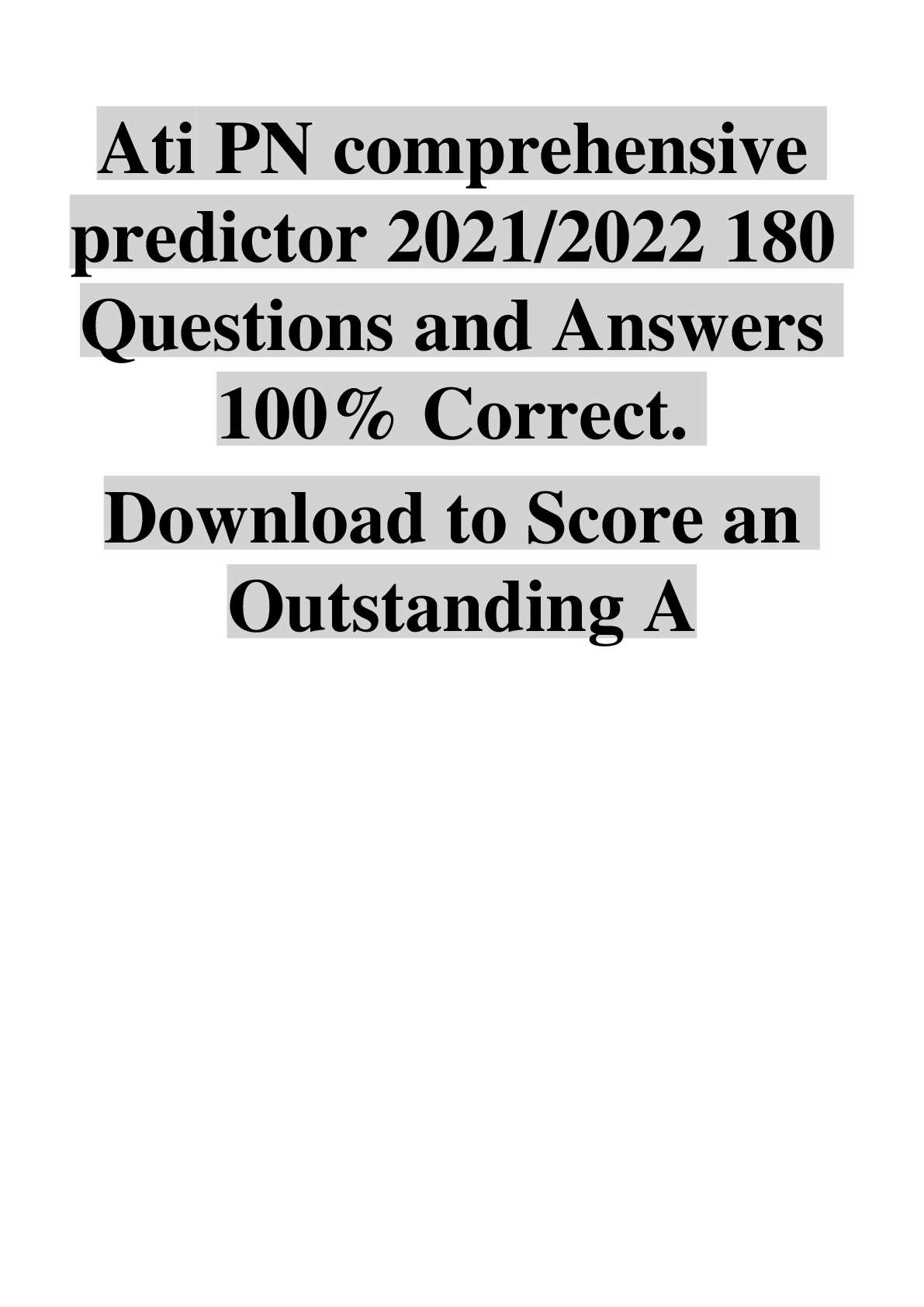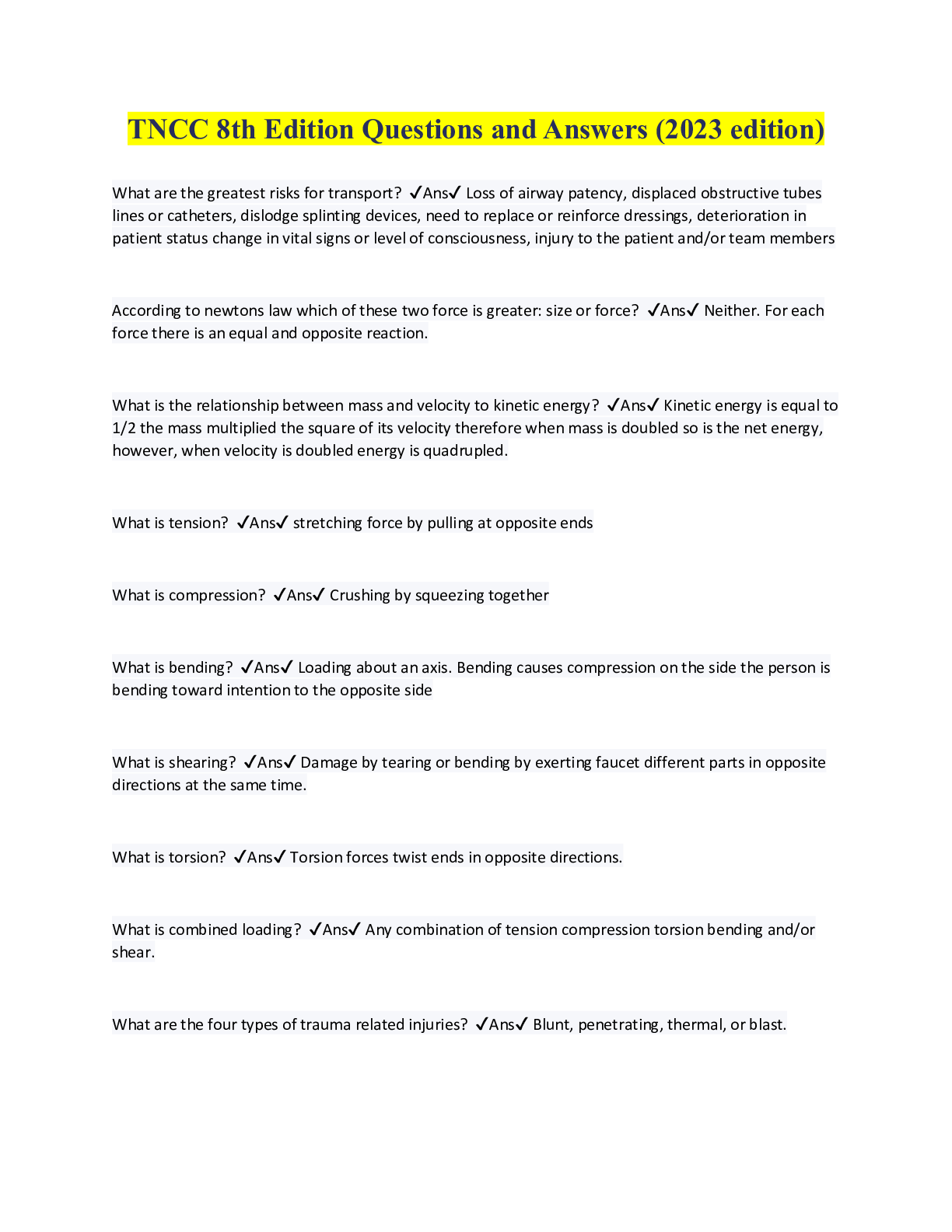NURSING NR 509 APEA Neurology Questions and Answers Graded A(Latest 2021)
Document Content and Description Below
NURSING NR 509 APEA Neurology Questions and Answers Question 1: Sudden, brief, rapid jerks, involving the trunk or limbs may be consistent with: a myoclonic seizure. Correct an absent seizure. ... a myoclonic atonic seizure. a focal seizure with impairment of consciousness. Explanation: A patient experiencing a myoclonic seizure manifests sudden, brief, rapid jerks, involving the trunk or limbs. A sudden brief lapse of consciousness with momentary blinking, staring, or movements of the lips and hands but no falling is consistent with an absent seizure. During a myoclonic atonic seizure, the patient experiences a sudden loss of consciousness with falling but no movements. Injury may occur. Focal seizures with impairment of consciousness the person appears confused. Automatisms include automatic motor behaviors such as chewing, smacking the lips, walking about, and unbuttoning clothes. Question 2: Which of the following neurological assessment findings indicate the need for further evaluation? Lifting one foot and then the other when the infant is held upright with the feet touching a solid surface Fanning and hyperextension of the toes when the sole is stroked upward from the heel Grasping a finger placed in the neonate's palm Weak and ineffective sucking movements Correct Explanation: Weak and ineffective sucking movements would indicate the need for further evaluation since any weak, absent, asymmetrical or fine jumping movements would suggest neurological system disorders. The other choices represent common reflexes found in the normal newborn: Babinski, grasping, and stepping. Question 3: An example of proximal weakness is: the right shoulder. Correct the right hand. both arms. Incorrect on the right side of the face. Explanation: There are 4 different patterns of weakness: Proximal, distal, symmetric, and asymmetric. An example of proximal weakness is weakness in the shoulder or hip girdle. Distal weakness occurs in the hands or feet. Symmetric weakness occurs in the same areas on both sides of the body. An asymmetric weakness occurs in a portion of the face or extremity - a form of focal weakness. Question: A female patient complains of weakness in her hand when opening a jar. This finding could be suggestive of which type of weakness pattern? ProximalDistal CorrectSymmetricAsymmetric Explanation: To identify distal weakness, ask about hand movements when opening a jar, can or using scissors or a screwdriver. Another example is a problems like tripping when walking. Question: A patient presents with an altered level of consciousness. He/she is considered in a stuporous state if he/she: appears drowsy but opens the eyes, looks at the examiners, answers the questions, and then falls asleep.arouses from sleep after exposure to painful stimuli, exhibits slow verbal responses, and easily lapses into an unresponsive state. Correctremains unarousable with eyes closed. There is no evident response to inner need or external stimuli.opens the eyes and looks at the examiner, but responds slowly and is somewhat confused. Explanation: A stuporous patient arouses from sleep after exposure to painful stimuli, verbal responses are slow, and lapses into an unresponsive state. A lethargic patient appears drowsy but opens the eyes, looks at the examiners, answers the questions, and then falls asleep. An obtunded patient opens the eyes and looks at the examiner, but responds slowly and is somewhat confused. A comatose patient remains unarousable with eyes closed. There is no evident response to inner need or external stimuli. Question: One way to assess cerebellar function would be to have the patient: hop on one foot. Correctread out loud. Incorrectshrug the shoulders.discriminate between light and sharp pain. Explanation: The cerebellar function tests are used to monitor the patient's sense of equilibrium, which includes the patient's gait (walk), ability to stand upright with eyes closed (Romberg test), touch finger to nose, and move the heel to opposite knee while lying down. Other examples also include: hopping on one foot, walking heel-to-toe, and touching the examiner's finger and the examinees' nose. Reading out loud tests visual acuity; shrugging shoulders assesses the spinal accessory nerve and discriminating pain between light and sharp assesses the sensory system. Question: Hypesthesia refers to: absence of touch sensation.decreased sensitivity to touch. Correctincreased sensitivity to touch. Incorrectabsence of pain sensation. Explanation: Anesthesia is absence of touch sensation; hypesthesia is decreased sensitivity to touch; hyperesthesia is increased sensitivity to touch; and analgesia refers to absence of pain sensation. Question: When conducting a neurologic exam, which one of the following assessments is not considered part of the mental status assessment? Level of alertnessCranial Nerve II (CNII) CorrectAppropriateness of responsesOrientation to time Explanation: When conducting a neurologic exam, mental status assessment should include evaluation of the level of alertness, appropriateness of responses, and orientation to person, place, and time. Assessing cranial nerve II would be part of the cranial nerve assessment. Question: A mother reports to the nurse practitioner that her teenager might be taking drugs because earlier today the teenager had a mild seizure and now has an unstable gait and is beginning to complain of shortness of breath. These symptoms might be consistent with a possible overdose of: barbiturates.amphetamines. Correctmarijuana.opioids. Explanation: Amphetamines are central nervous system (CNS) stimulants. The teenager could exhibit signs of ataxia, respiratory distress, seizures, coma, myocardial infarction, death if he/she consumed this substance. Impaired memory, judgment, and attention, slurred speech, drowsiness, and irritability are suggestive of central nervous system depressants (CNS). Barbiturates, alcohol and benzodiazepines fall in this class. Opioids may cause euphoria, drowsiness, constricted pupils and some of the same symptoms as CNS depressants. Marijuana intoxication would present with relaxation, euphoria, detachment, talkativeness, slowed perception of time, and possible anxiety or paranoia. Question: An ischemic stroke is: a transient episode of neurologic dysfunction by focal brain, spinal cord, or retinal ischemia, without acute infarction. Incorrectan infarction of the central nervous system tissue that may be silent or symptomatic. Correctthe abrupt onset of motor or sensory deficits.focal or asymmetric weaknesses caused by central and peripheral nerve damage. Explanation: Ischemic stroke is “an infarction of central nervous system tissue” that may be symptomatic or silent. TIA is now defined as “a transient episode of neurological dysfunction caused by focal brain, spinal cord, or retinal ischemia, without acute infarction.” The other terms are not related to the new definitions. Question: By placing the patient in the supine position, the nurse practitioner raises the patient's relaxed and straightened leg while flexing the leg at the hip, then dorsiflexes the foot. This maneuver is known as: Kernig's sign.the straight-leg raise. Correctthe plantar response.the ankle reflex. Explanation: By placing the patient in the supine position, the nurse practitioner raises the patient's relaxed and straightened leg while flexing the leg at the hip, then dorsiflexes the foot. This maneuver is known as the straight leg raise and is used to evaluate sciatica. It is positive if there is pain down the back of the leg below the knee. Ipsilateral calf wasting and weak ankle dorsiflexion may be present. Question: The level of consciousness that refers to the patient that appears drowsy but can open his eyes, respond to questions, then fall back to sleep is known as: obtundation.alertness.lethargy. Correctstupor. Explanation: Lethargy refers to the patient that appears drowsy but can open his eyes, respond to questions, then fall back to sleep. An obtunded patient opens his eyes, looks at the person speaking to him but responds slowly and appears confused. The level of consciousness that refers to the ability of the patient to respond fully and appropriately to stimuli is known as alertness. A stuporous patient arouses from sleep only after painful stimuli. Question: When assessing coordination of muscle movement, four areas of the nervous system function in an integrated way. These areas include the motor, cerebellar, the vestibular, and the sensory systems. Which system coordinates a steady posture? Motor systemCerebellar system CorrectVestibular systemSensory system Explanation: Coordination of muscle movement requires that four areas of the nervous system function in an integrated way: motor system for muscle strength, cerebellar system for rhythmic movements and steady posture, vestibular system for balance and coordinating eye, head, and body movements, and sensory system for position sense. Question: An older adult presenting with signs of undernourishment, slowed motor performance, and loss of muscle mass or weakness suggests: depression.frailty. CorrectParkinson's disease.Alzheimer's disease. Explanation: Undernutrition, slowed motor performance, loss of muscle mass, or weakness suggests frailty. Question: Postural tremors appear when the affected part is: at rest.moving voluntarily. Incorrectis actively maintaining a posture. Correctgetting closer to its target. Explanation: Tremors are rhythmic oscillatory movements. Postural tremors appear when the affected part is actively maintaining a posture. Examples include the fine rapid tremor of hyperthyroidism, the tremors of anxiety and fatigue, and benign essential tremor. The other choices are not consistent with postural tremors. Question: A discriminative sensation that describes the ability to identify an object by feeling it is: graphesthesia.stereognosis. Correcttwo point discrimination.astereognosis. Incorrect Explanation: A discriminative sensation that describes the ability to identify an object by feeling it is stereognosis. The patients eyes must be closed. Graphesthesia, or number identification, is the ability to identify a number when drawn in the hand of a patient whose eyes are closed. The ability to identify an object touching 2 areas simultaneously is termed two-point discrimination. Astereognosis is a term used to describe the inability to recognize objects placed in the hand. Question: When evaluating a patient for weakness of the upper extremities, bilateral distal weakness is noted. This finding could be suggestive of: alcohol myopathy.polyneuropathy. Correctmyositis.neuromuscular junction disorders. Incorrect Explanation: Bilateral predominantly distal weakness suggests a polyneuropathy, as in diabetes. Proximal limb weakness, usually symmetric and without sensory loss, occurs in myopathies from alcohol, glucocorticoids, and inflammatory muscle disorders like myositis and dermatomyositis. In the neuromuscular junction disorder myasthenia gravis, there is proximal, typically asymmetric weakness that gets worse with effort. Question: When observing for thenar atrophy of the hands, a typical observation is: furrowing in the spaces between the metacarpals. Correctthenar eminences appear full.the hypothenar eminences would appear convex.the spaces between the metacarpals would be slightly depressed. Explanation: Flattening of the thenar and hypothenar eminences and furrowing between the metacarpals suggests atrophy. Localized atrophy of the thenar and hypothenar eminences suggests damage to the median and ulnar nerves. Normally, the metacarpal spaces are full and slightly depressed and the thenar and hypothenar appear full and convex. Motor neuron disease, rheumatoid arthritis, and protein-calorie malnutrition can cause atrophy in the hand. Question: Fasciculations in atrophic muscles suggest: a lower motor neuron disease. Correctrheumatoid arthritis. Incorrectperipheral nervous system disease.a central nervous system disorder. Explanation: Fasciculations are small muscle twitches and can be found in any muscle of the body. Fasciculations are not usually serious but can be annoying. If they occur in atrophic muscles, this may suggest a lower motor neuron disease. They are not seen in central or peripheral nervous system disease or rheumatoid arthritis. Question: The part of the brain that controls most functions in the body and is responsible for breathing, heart rate, and articulate speech is the: cerebrum.brainstem. Correctcerebellum.diencephalon. Explanation: The nerve connections of the motor and sensory systems from the main part of the brain to the rest of the body pass through the brainstem. The brainstem controls most functions in the body but mostly responsible for breathing, heart rate, and articulate speech. The cerebrum controls all voluntary actions of the body with the aid of the cerebellum. The diencephalon relays sensory information between brain regions and controls many autonomic functions of the peripheral nervous system. It also connects structures of the endocrine system with the nervous system and works in conjunction with limbic system structures to generate and manage emotions and memories. The cerebellum, which lies at the base of the brain, coordinates all movement and helps maintain the body upright in space. Question: Assessing the neurological status of a child with a ventriculoperitoneal shunt should include: use of the Glasgow coma scale. CorrectKernig's sign.brudzinski's sign.Monroe-Kellie doctrine. Incorrect Explanation: The Glasgow coma scale addresses eye, verbal, and motor responses to determine a neurological assessment score and is the first sign of improvement or deterioration in neurological status. Also, signs of increased intracranial pressure should be assessed. Kernig's sign is any resistance or pain when the child is supine and the leg is extended and knee bent. A positive sign is more consistent with meningitis. Brudzinski's sign is an involuntary flexion of the knee or hip when the child is in the supine position and the neck is flexed and is also consistent with meningitis. The Monroe-Kellie Doctrine states that the sum of brain, CSF, and blood within the cranial vault is constant. So an increase or decrease in one causes a compensatory increase or decrease in one or both of the others. It is an hypothesis and not an assessment. Question: What geriatric condition is characterized by normal alertness but progressive global deterioration of cognition in multiple domains? DeliriumCognitive impairmentParkinson's diseaseAlzheimer's disease Correct Explanation: Alzheimer's disease is a geriatric condition in which normal alertness is present but progressive global deterioration of cognition occurs in multiple domains, including short-term memory, but with sparing of memory for remote events, subtle language errors, visuospatial perceptual difficulties, and changes in executive function, or the ability to perform sequential tasks such as instrumental activities of daily living (IADLs). Delirium is a serious disturbance in a person's mental abilities that results in a decreased awareness of one's environment and confused thinking. Cognitive impairment is an intermediate stage between the expected cognitive decline of normal aging and the more serious decline of dementia. Parkinson's disease is a progressive disorder of the nervous system that affects movement. [Show More]
Last updated: 1 year ago
Preview 1 out of 43 pages
.png)
Reviews( 0 )
Recommended For You
Applied Science> EXAM > RBT Training Flashcards - RBT Training Modules | 281 Questions and Answers 100% Correct | COMPLETE | 42 Pages (All)

RBT Training Flashcards - RBT Training Modules | 281 Questions and Answers 100% Correct | COMPLETE | 42 Pages
1A: The main purpose of this RBT training is to? - ✔✔Improve the lives of individuals with autism 1B: The three branches of the science of behavior analysis are the - ✔✔Experimental analysis of beh...
By Tessa , Uploaded: Aug 08, 2022
$12
Food and Nutrition> EXAM > ServSafe Manager Exam. COMPLETE SOLUTION with 80 Questions And Answers. (All)

ServSafe Manager Exam. COMPLETE SOLUTION with 80 Questions And Answers.
what should you do when taking a food order from customers who have concerns about food allergies - ✔✔Describe each menu item to the customer who ask, including any "secret" ingredients What temper...
By Tessa , Uploaded: Jun 24, 2022
$11
*NURSING> EXAM > TNCC Final Exam Test 2022 Open Book. 50 Questions And Answers (All)

TNCC Final Exam Test 2022 Open Book. 50 Questions And Answers
TNCC final exam test 2022 open book Why is a measure of serum lactate obtained in the initial assessment of the trauma patient? a) to measure oxygenation and ventilation b) to quantify the base de...
By Axeldee , Uploaded: May 04, 2022
$12
*NURSING> EXAM > NGR 6619 Barkley Study Test 3 Questions And Answers 2022/2023 (All)

NGR 6619 Barkley Study Test 3 Questions And Answers 2022/2023
Exam 3 1. You are starting your shift after a 56 y/o male pt, Daniel, has been admitted to the ICU for DKA. Already exhibiting confusion and irritability. His blood gases are pH=7.28, pCO2=33. HCO3=...
By Good grade , Uploaded: Apr 25, 2022
$10
Biology> EXAM > TNCC 8th Edition Questions And Answers( With Complete Solution Rated A) (All)

TNCC 8th Edition Questions And Answers( With Complete Solution Rated A)
TNCC 8th Edition Questions And Answers( With Complete Solution Rated A)
By Axeldee , Uploaded: May 08, 2022
$11
*NURSING> EXAM > NCLEX RN Versions 1 -12 (Latest) With 850 Questions And Answers Guaranteed 100% Grade A. (All)

NCLEX RN Versions 1 -12 (Latest) With 850 Questions And Answers Guaranteed 100% Grade A.
NCLEX RN Versions 1 -12 (Latest) With 850 Questions And Answers Guaranteed 100% Grade A
By Rixx Dennis , Uploaded: Jul 19, 2021
$30
*NURSING> EXAM > Prophecy- Core Mandatory Part II (Nursing). 30 Questions and Answers (All)

Prophecy- Core Mandatory Part II (Nursing). 30 Questions and Answers
What should you assess regardless of age group? Confusion or Depression The National Patient Safety Goal 6 is to improve the safety of clinical alarm systems. What is the rationale for this goal? *...
By liza , Uploaded: Apr 26, 2022
$11
*NURSING> EXAM > Ati PN comprehensive predictor 180 Questions and Answers 100% Correct. Download to Score an Outstanding A (All)

Ati PN comprehensive predictor 180 Questions and Answers 100% Correct. Download to Score an Outstanding A
. A nurse is planning to obtain a 12-lead ECG for a client who has a history of cardiac dysrhythmias. Which of the following actions should the nurse plan to take? - tell the client to expect a mild...
By PHISHER , Uploaded: May 16, 2022
$15
Trauma Nurse Core Course (TNCC)> EXAM > TNCC 8th Edition Questions and Answers. (Updated 2023) Trauma Nurse Core Course (TNCC). 52 Questions with 100% Correct Answers (All)

TNCC 8th Edition Questions and Answers. (Updated 2023) Trauma Nurse Core Course (TNCC). 52 Questions with 100% Correct Answers
What are the greatest risks for transport? - ✔✔Loss of airway patency, displaced obstructive tubes lines or catheters, dislodge splinting devices, need to replace or reinforce dressings, deteriorati...
By Tessa , Uploaded: May 11, 2022
$11
*NURSING> EXAM > ATI PN comprehensive predictor 2020/2021 180 Questions And Answers.(SCORE A GUARANTEED) (All)
.png)
ATI PN comprehensive predictor 2020/2021 180 Questions And Answers.(SCORE A GUARANTEED)
Ati PN comprehensive predictor 2020/2021 180 Questions And Answers.(SCORE A GUARANTEED)
By Rixx Dennis , Uploaded: Nov 17, 2021
$46
Document information
Connected school, study & course
About the document
Uploaded On
Feb 27, 2021
Number of pages
43
Written in
Additional information
This document has been written for:
Uploaded
Feb 27, 2021
Downloads
0
Views
78






